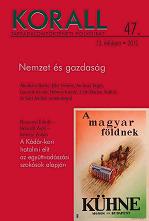Nagybirtok, paraszt és nemzet. Az 1919–1920-as közép-kelet-európai földreformok eszmei előfutárai a politikai-gazdasági közbeszédben
Large Estates, Peasants and Nation: The Ideological Precursors of the 1919–1920 Central Eastern European Land Reforms in the Political and Economical
Author(s): András VáriSubject(s): History
Published by: KORALL Társadalomtörténeti Egyesület
Summary/Abstract: There are several detectable ideological precursors of Central and Eastern European land reforms of 1919–1920. However, these old “sherds” of ideology are not sufficient, even in their totality, to “explain” the advent of land reforms. As compared to the more forcible and larger scale confiscation of property in the course ofthe land reforms, any previous state settlement and similar precursors were inconsiderable. These ideas and ideological elements, however, may still serve as bridges in the course of events leading to land reforms in three distinct ways. First, they already contain the idea that the state is responsible for shaping the structure of society, even if it entails the intervention into private property or families. Secondly, these ideas also suggest that the state can consult “experts in this undertaking. Thirdly, the idea emerged that large estates serving as the essential basis for the old feudal elite should be replaced by a better distribution of land. The logic of the world war brought three further catalytic factor into the equation. First, some land had to be allocated for the victims of war and the returning soldiers. Secondly, mass displacement began as early as the Second Balkans War, and this caused the rise of the opinion that foreign population poses military risk. Lastly, military administration has already imposed confiscation and used force on the population, which escalated by the catastrophic shortage of supplies in the last year of the war. Despite all this, it is safe to state that the aforementioned precursors had much less impact on the historical events between 1918 and 1930 than they did on the historiography of the subject between 1989 and 2011.
Journal: Korall - Társadalomtörténeti folyóirat
- Issue Year: 2012
- Issue No: 47
- Page Range: 5-29
- Page Count: 25
- Language: Hungarian

